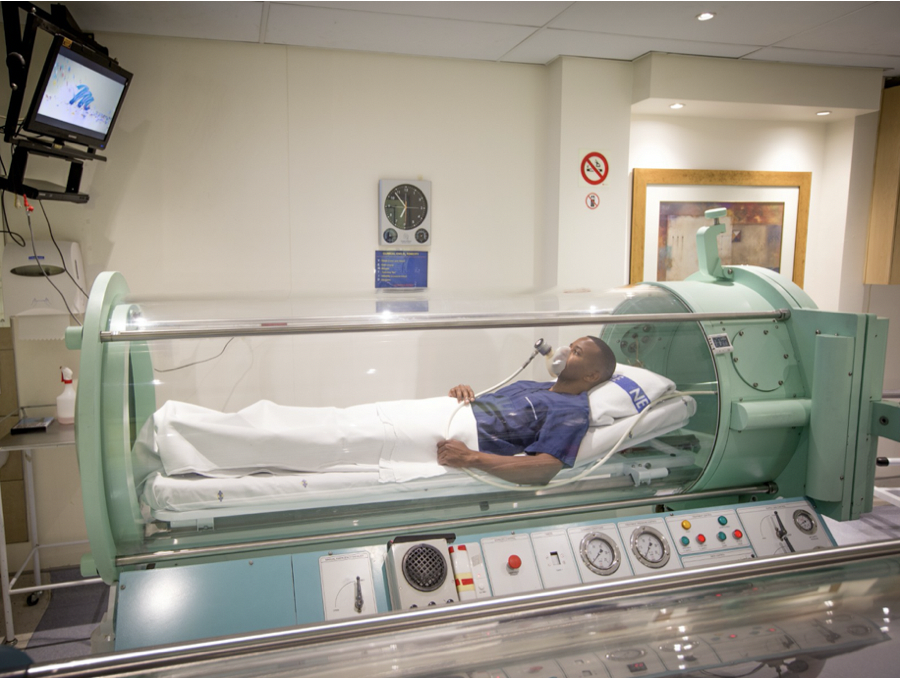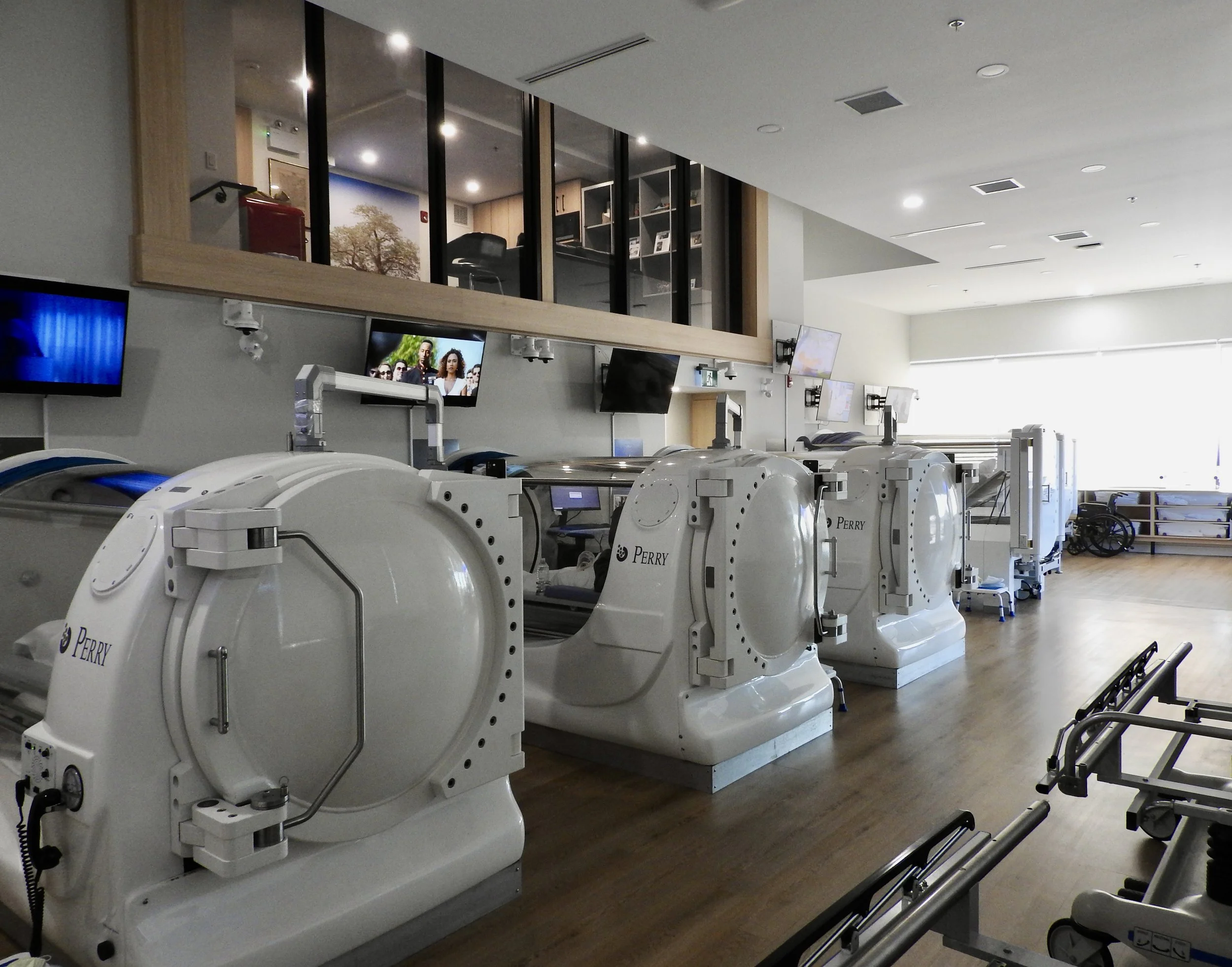HOW IT STARTED
Music played a key role at the beginning.
In 2015, Daniel Gericke was Technical and Safety Director at the Judy Dan Research & Treatment Centre in North York, when Deane Nesbitt Jr. came in for hyperbaric oxygen therapy to heal burns resulting from prostate cancer radiation. At the time, Deane was engaged in composing music and recording CDs.
Daniel was the only one at the Centre who didn’t provide treatment to Deane. However, Deane quickly recognized a kindred spirit and always made a point of crossing the hall to Daniel’s domain to say hello.
Daniel asked Deane to stay for a coffee one day and they discussed music. Deane subsequently brought in one of his CDs, which included his most-played track, Canadian Summer. It became a favourite of Daniel’s.
When Deane had finished his treatment, Daniel asked him if he would do something with his music for the upcoming Undersea and Hyperbaric Medical Society (UHMS) international conference in Toronto. Deane gave a talk and screened a music video of his, Anthem for the Unsung Hero, that included hyperbaric oxygen therapy.
Change for Chimps, a short film featuring Jane Goodall and which had Deane’s music as soundtrack, subsequently played a role in fundraising for one of Daniel’s hyperbaric facilities at Milpark Hospital in Johannesburg.
It was after an article about this was published in a hyperbaric magazine that Deane asked Daniel if he would be interested in opening a new hyperbaric clinic together.
The Partners
The two think very much alike and share the same values and work ethic. On the downside, they each have the same chronic tendency to misplace things like glasses and keys in record time. They both have four names, with one that the public has difficulty pronouncing. Gericke is pronounced HEAR-ick-uh, not GAIR-ick. Deane is pronounced DEEN, not Day-AN.
From the start, Daniel and Deane wanted to create a clinic that patients would look forward to visiting. Nobody having to take a number. No impersonal call-out of your name. No disturbing posters on the wall. Instead, they wanted an environment where you would be greeted on arrival and immediately made to feel at home.
It took a year to search out where an HBOT facility was needed and where oxygen could be obtained. Dr. Joseph Kay at the Oakville Trafalgar Memorial Hospital mentioned that there was space in the new North Oakville Medical building on the grounds of the hospital. Daniel and Deane thought this was ideal as Oakville did not have any hyperbaric facilities and so their clinic would also bring value to the hospital and the area. They were very excited about the idea and made an offer to purchase the space.
A spot still had to be found where an oxygen tank could be built. After extensive negotiations with the hospital, it was agreed that the facility could connect to the hospital’s own oxygen tank. This was the most efficient solution, except for the fact that the hospital’s tank was 350 metres away. Undaunted, the two sought out trenching experts and medical gas installation specialists and a 350-metre pipeline was built. A feat in itself, the pipeline was installed mainly using horizontal drilling, with minimal disturbance to the landscape and pavement.
The two have given freely of their time to non-profit work in the medical field over many years and each brings complementary qualifications to the table.
Daniel Gericke
After serving in the South African Navy Marines and Diving Unit, specializing in underwater explosive clearance, Daniel became the Director of the South African Navy Decompression Chamber Program. He founded the first multiplace hyperbaric medical centre in South Africa at Saint Augustine’s Hospital in Durban, followed by a sister monoplace facility at Milpark Hospital in Johannesburg.
Moving to Bermuda, Daniel became Safety Director at the Bermuda Hospitals Board and the Island’s multiplace facility achieved its first safety accreditation. Due to Daniel’s stewardship, Bermuda’s King Edward Memorial Hospital Hyperbaric Centre was chosen as a Divers Alert Network (DAN) Preferred Provider Facility. Daniel was nominated as DAN International’s Top Instructor Trainer.
He served two terms as Secretary of the Canadian Undersea and Hyperbaric Medical Association (CUHMA), participating in compiling guidelines to the practice and assisting with risk assessments and planning committees. He currently serves as HBO Chamber Operations Training Director for the Southern African Undersea and Hyperbaric Medical Association (SAUHMA).
Deane Nesbitt Jr.
Deane has served on numerous boards, seven being hospital or health related, and currently is on a board of Johns Hopkins Medicine in Baltimore. He obtained a certificate in the Fundamentals of Hyperbaric Medicine from Simon Fraser University and is familiar, of course, with HBOT from a patient’s perspective. Although he has Scuba-dived, he has spent more time at higher altitudes, flying a Cessna 150.
He practised law first with a firm (now Borden Ladner Gervais) and then on his own, obtained a certificate from the Owner-President Management Program at the Harvard Business School, co-founded an investment management company in Toronto (Vestcap), served on the board of Nesbitt Thomson (now BMO Nesbitt Burns), wrote an award-winning history about it, and then pursued his life-long interest in music full time.
In the 1990s Deane acquired the rights to the name of the Packard motor car for Canada, with the intention of producing a 1999 100th anniversary edition. A builder in Ontario was ready to manufacture the car. However, General Motors in Detroit contested the whole project, maintaining that the public would confuse the car with its company, Packard Electric. In law, a delay can be as good as a win, and when GM finally dropped the claim two and a half years later, it had accomplished its goal of thwarting the project, for it was too late to produce the car for Packard’s anniversary. The mascot pictured, however, is alive and well and the company that was formed for the project is now Gericke-Nesbitt Inc.
The Facility
With special attention to individual needs, the facility strives to provide a warm, welcoming and tranquil environment for patients undergoing hyperbaric oxygen therapy. In that connection, it draws on the beauty of nature – with its forest murals, greenery and clean wood finishes – as well as music, including Deane’s.
The clinic’s six chambers are among the most spacious and comfortable in the industry. Although the clinic is upscale, patients do not have to pay the cost of the hyperbaric treatment for any one of the 14 specific conditions outlined by the UHMS. Those costs are looked after by OHIP.
The facility’s team includes Medical Director, Dr. Joseph Kay, mentioned earlier, who is a hyperbaric and diving medicine physician as well as a Transport Canada Marine Medical Examiner, and Clinic Manager, Tanya Dort, who has over 25 years’ experience in frontline patient care and who meets patients with a warm welcome that makes them feel very much at home.
The operation’s logo is the baobab tree with branches forming the initials G and N. Known as the “tree of life,” this amazing tree stores water in its vast trunk and can produce fruit when everything around it is affected by drought.
Halton Hyperbarics – Gericke-Nesbitt Regenerative Medicine (both registered names of Gericke-Nesbitt Inc.) has completed its first year of operations and the feedback from its patients has been most rewarding.
Left to right: Ramy Moussa, CHT, Deane Nesbitt Jr., Partner, Daniel Gericke, Partner, Olu Adelekan, Clinic Assistant/Patient Coordinator, Tanya Dort, Clinic Manager, Alexa von Steun, CHT in training, Dr. Joseph Kay, Medical Director, Uzma Hussain, CHT in training, March 2023






